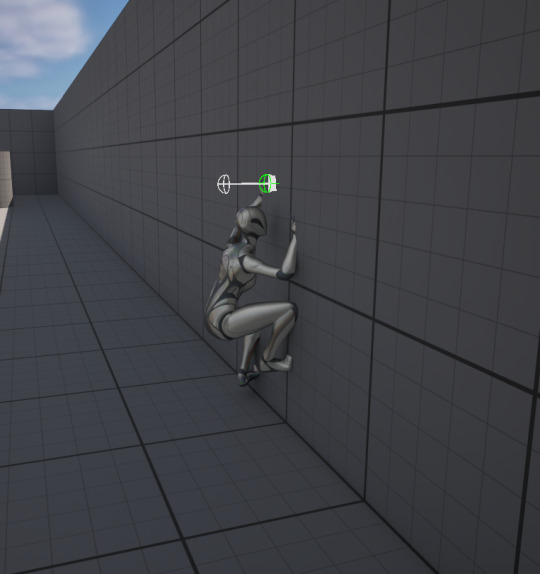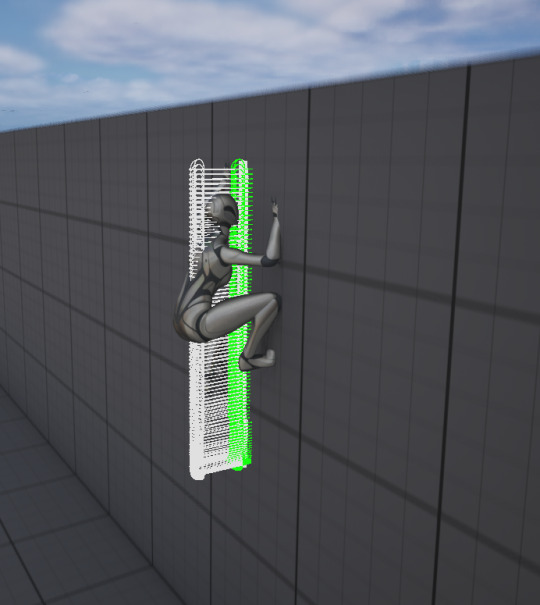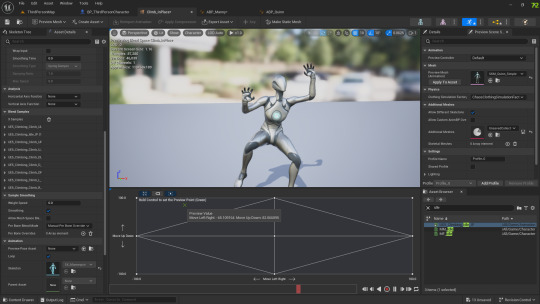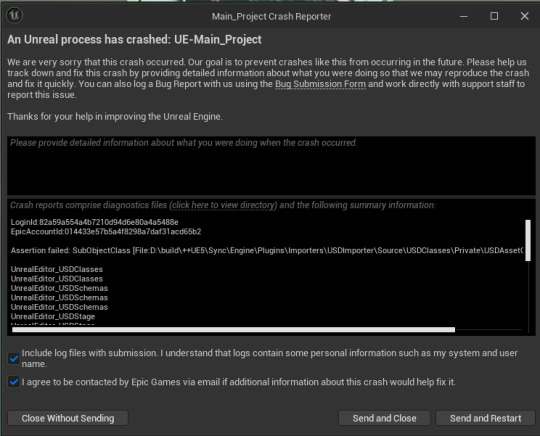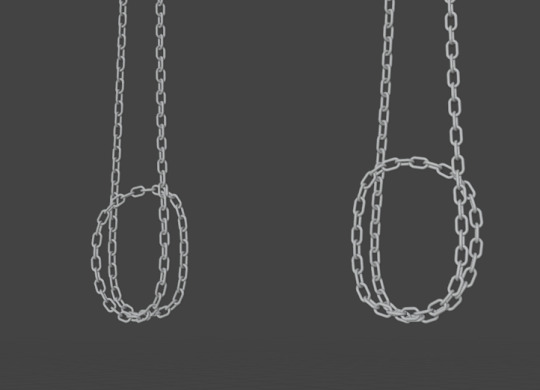Text
Modelling Assets and Importing to Unreal Engine 5
I used all the reference I could from the pictures I could find of the exhibition and modelled it in Blender. I tried to keep it as realistic as possible and also tried to add as much detail while keeping the polycount low to have the game engine run smoothly.
The reason I needed it detailed is because the objects are going to be very large, so the assets need as much detail to not have them feel empty or boring when the player interacts with them.

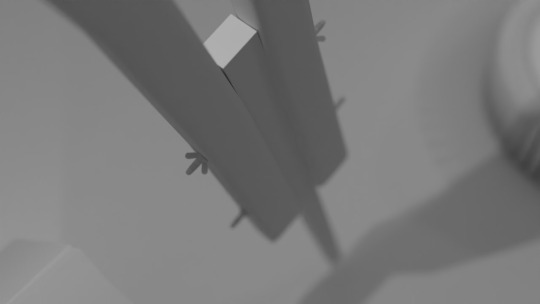

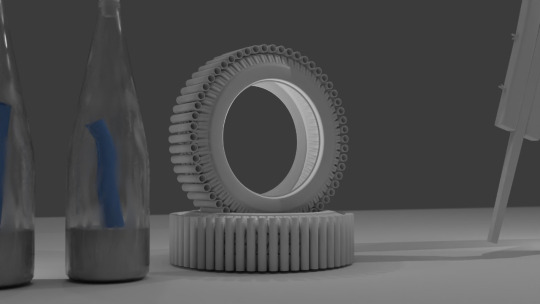
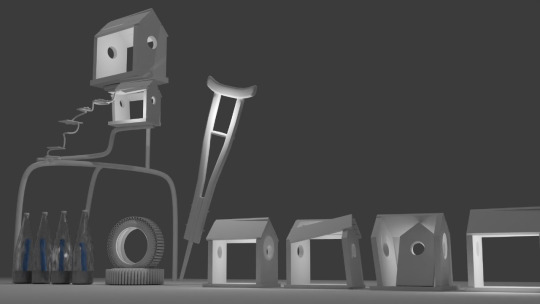
After modelling the environment, I imported it into Unreal Engine 5 and then tested the sizing as well as and added complex collisions to play test the level (without any systems)
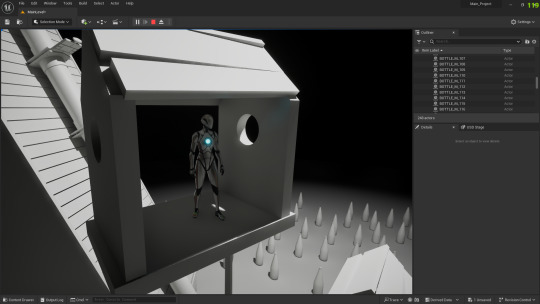
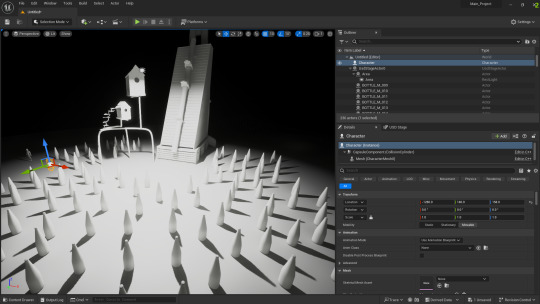

0 notes
Text
Asset List:
Models:
Bird Houses
Tyres
Crutches
Right-angled triangular form (constructed out of salvaged school desks)
Metal Poles and Beams
Plastic/Glass Bottles
Grass and Sand
Textures:
Wood
Plastic
Glass
Metal
Concrete
0 notes
Text
Level Design - Map Layout
To better understand the level design I came up with, I decided to start off by blocking it out in 3D itself. Since my idea was to have the player climb the exhibits, that meant the level design would have to be vertical.
I had some trouble trying to figure out how to place the different objects around. However, after researching and reading up on a few level design resources I got the hang of it.
The level is quite short, but I plan to make it challenging for the player to get to the top, which would urge all completionists to try and reach the end of the level. Failing to properly climb the exhibits would result in a punishing consequence of falling off as there are no safety rails.

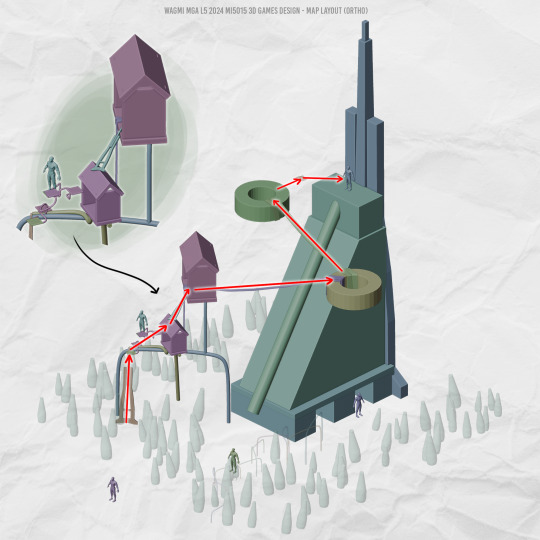
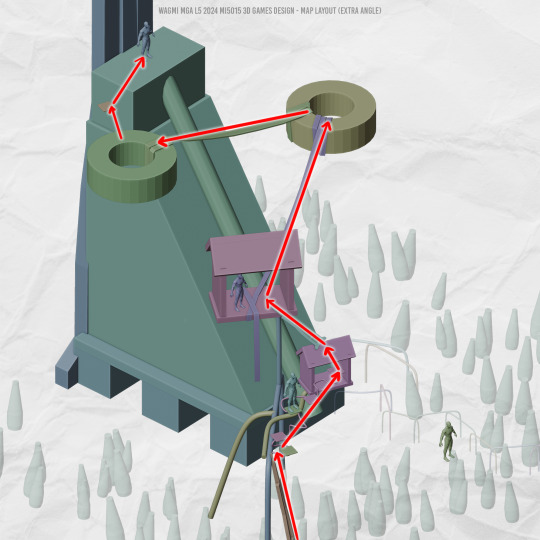

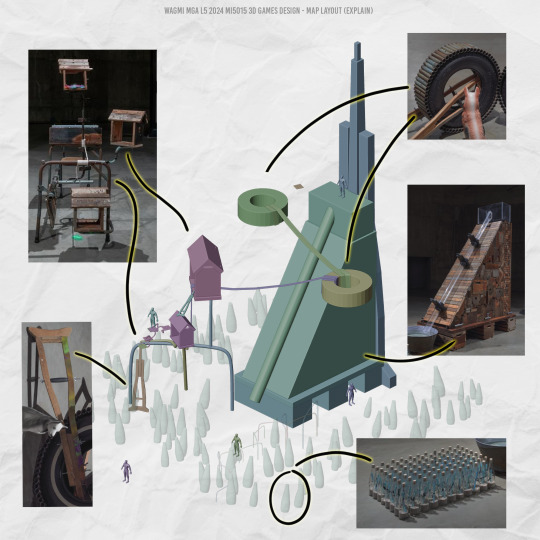
Designing the level in Blender

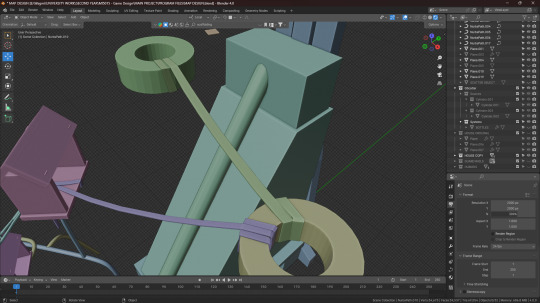
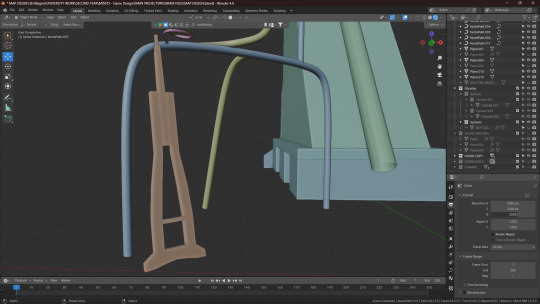


Resources:
Layout - The Level Design Book
Games that were inspirations:
Only Up! 2023
Neon White 2022
It Takes Two 2021
0 notes
Text
Finalized Concept
Finally! The concept that I decided to go with was the Exploration Based game. I realized that this would be the one that I would have the best time making and also would be the best concept for me to bring the artist's thoughts and ideas across to the audience.
The Brief says:
"Develop a level design that successfully communicates the artist's work to an audience that is unaware of their work. Although it is entirely possible to make your level interactive, the visual scripting system can be daunting at first and it is recommended that you keep interactive elements simple and to a minimum."
"The aim Is to develop a level that communicates the style and look of the game rather than demonstrate interaction/animation/physics/ mechanics."
All the other concepts I had would require complex systems and mechanics that would take up most of my time and effort in making the game. This concept would make it much easier for me to focus on what's important and to concentrate on the meaning of the artist's work.
The idea I had from the start was to have a world where the Player is much smaller than the art he is looking at it. Kemang Wa Lehulere combats issues and problems in the world that, at first, seem too big for one person to fight against. Social and Political issues that he deems to be important problems that affect millions across the world.
"Kemang Wa Lehulere’s solo exhibition “Bring Back Lost Love” attempted to formulate the problem of loss and reclamation—of land, dignity, and ultimately, love. A gathering of drawings and mixed-media installations let us feel the weight of history."-Kemang Wa Lehulere – Artforum
Since these exhibits embody and represent the very issues he talks about; I would want my game to showcase his sculptures and art pieces as larger-than-life, giant exhibits, having them tower over the player.
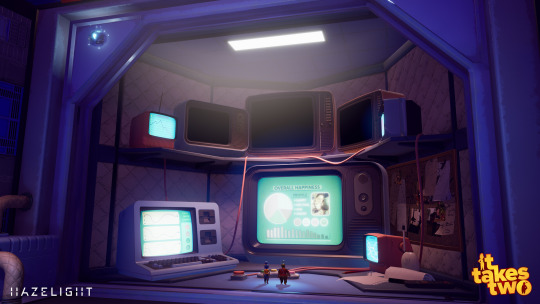
I would start by having the player climb these structures, traversing them to metaphorically imply that the player is overcoming these obstacles and actively trying to defeat these issues that he (Kemang) talks about.
The game would encourage the player to look around, to notice the different things on the walls and to perhaps interact with them as they navigate the sculptures.
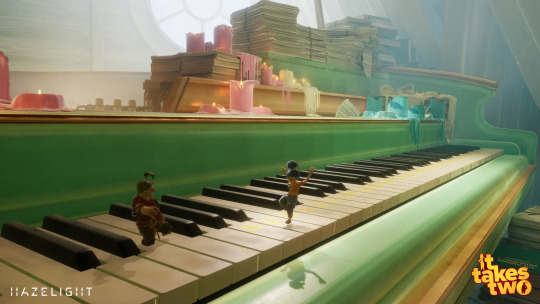
At the end of the game, the player would have come to a vantage point, above all the sculptures they just climbed, effectively defeating and overcoming these problems. They would stand high above and look down on the exhibits that were once behemoths compared to themselves.
The player's bird's eye view effectively ends the game with the notion that even though these problems and obstacles seem to be giants, we can still rise above them if we are dedicated enough, just as Kemang has committed his art to inform us about these issues.
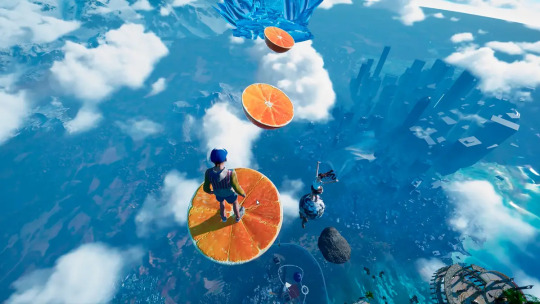
Images from the game "It Takes Two" "Only Up 2"
Hazelight Studios It Takes Two Art Blast - ArtStation Magazine
0 notes
Text
Concepts for the Game in Unreal Engine
With my artist being very closely associated with props and objects of different sorts, I had a few ideas for what my game could be. Since I don't have much experience with Unreal Engine, I decided to keep the concept simple with a few intriguing points to grab the player's attention.
Concept #1 - Puzzle
My first concept idea was a "Puzzle" game, the typical "place the object on this to activate the door" kind of game. Pressure-sensitive plates and trip wires would be the main mechanics of the game since this would be relatively simple to replicate in a game.
I found a few YouTube tutorials as well which would make it easy for me to understand the basic Blueprint system that would make this work.
youtube
youtube
Concept #2 - 3D Platformer/ Precision Platformer
The second concept was an Platformer game similar to the likes of Only Up! and Neon White, where the gameplay focuses mainly on the player exploring the environment and trying not to fall off the map.
I have a strong interest in 3D Environment Design so this concept spoke to me a lot as well.
There would be a few interesting elements that I would put into the game such as unique traversal methods and interactable objects that would alleviate the lack of a specific gameplay mechanic.
I have this neat idea of having the sculptures supersized and having the player traverse these objects, vaulting, jumping climbing and mantling through them to get to the other side. I love the idea of a tiny human having to explore this world which seems giant to him/her. (ref: It Takes Two 2021 action-adventure platform video game, Honey, I Shrunk the Kids 1989 Sci-fi/Family Movie)
The game essentially involves the player exploring the 'exhibition theatre' where my artist's art is displayed. The player would have to get to the next exhibit by figuring out where it is and how to get there.
youtube
youtube
Concept #3 - Horror Obstacle Course
Last and maybe my least favourite one is a Horror Obstacle course that would have the player running from something while it chases him. That or, it would just have an eerie feeling to it, with the soundtrack as well as visuals. Maybe something to spice up the gameplay would be that the player has to collect items to progress to the next part of the level which would push the player and give them an objective.
I've always had an idea of doing a game with these types of visuals however, I do feel like it wouldn't necessarily conform with my artist and his work. Maybe I would end up mixing a few concepts together to make a new one, but for now, this is what I thought of. One piece of advice my lecturer gave me was to try and keep my concept simple and not overcomplicate it. The player would have to rush through the game going through multiple of my artist's sculptures.
youtube
youtube
0 notes
Text
I cut my skin to liberate the splinter: Act 5
Medium: Reconfigured wooden and metal school desks, wooden school chair, 2 leather suitcases, sand, grass, 2 wooden crates, porcelain dog, rope, rubber and feathers
[Source ‘I cut my skin to liberate the splinter: Act 1‘, Kemang Wa Lehulere, 2017 | Tate]
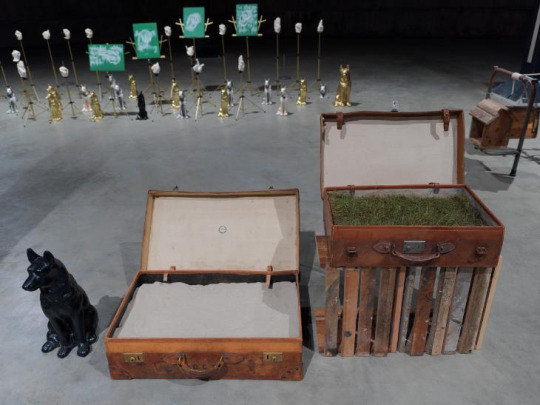

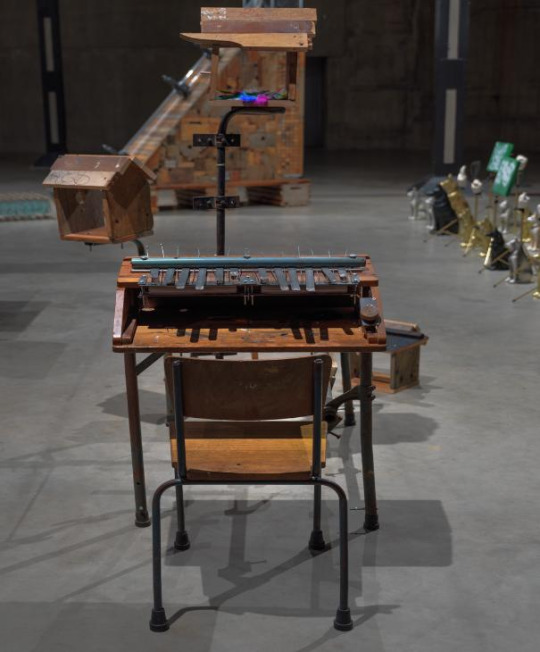
I cut my skin to liberate the splinter: Act 5 2017 consists of four birdhouses, one of which is placed on the floor, while the other three are connected by metal pipes (from salvaged school furniture) to each other and to two further elements. A desk-like panel is attached to a horizontal metal pipe facing downwards, rendering it impossible to use, while an additional form resembling a desk has been transformed into an mbira, an African musical instrument consisting of a wooden board with attached staggered metal tines, played by plucking the tines with one’s thumbs. Two leather suitcases, one filled with sand and another containing growing grass, complete the scene. During the performance, the mbira is played, brightly coloured feathers are blown from one of the birdhouses and a performer stands inside the suitcase filled with sand dancing to the sound of a trumpet before filling his pockets with sand. A further porcelain dog looks on.
[Source ‘I cut my skin to liberate the splinter: Act 1‘, Kemang Wa Lehulere, 2017 | Tate]

[Source: Kemang Wa Lehulere, I cut my skin to liberate the splinter, 2017, performance documentation. Courtesy: Performa and Marian Goodman Gallery, London; photograph: Paula Court - One Take: Kemang Wa Lehulere’s Performance of Self-Excavation | Frieze]
0 notes
Text
I cut my skin to liberate the splinter: Act 4
Medium: Wooden school door, reconfigured metal and wooden school desks, 2 rubber tyres, violin bow, piano wire and paint
[Source ‘I cut my skin to liberate the splinter: Act 1‘, Kemang Wa Lehulere, 2017 | Tate]
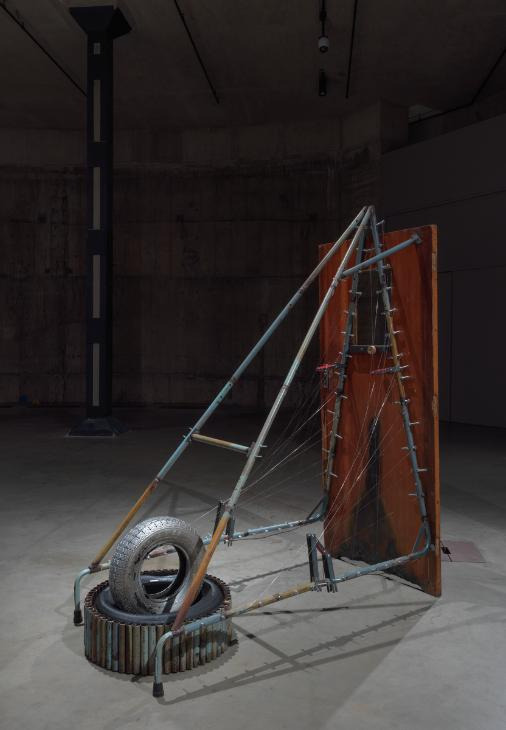

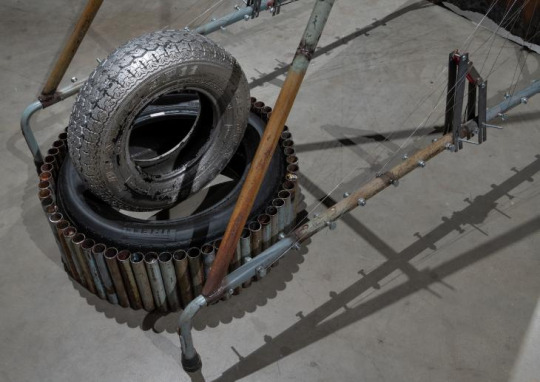
I cut my skin to liberate the splinter: Act 4 2017echoes the triangular shape of Act 1. A school door with a window provides the vertical plane of the right-angled triangle, which is supported by poles made from old school desks. Piano wire is strung between the door and metal A-frame structure. Like the other sculptures that comprise this work, Act 4 becomes an instrument that is played with a violin bow when activated.
[Source ‘I cut my skin to liberate the splinter: Act 1‘, Kemang Wa Lehulere, 2017 | Tate
0 notes
Text
I cut my skin to liberate the splinter: Act 3
Medium: Reconfigured wooden school desks, metal, wooden drumsticks and rubber
[Source ‘I cut my skin to liberate the splinter: Act 1‘, Kemang Wa Lehulere, 2017 | Tate]
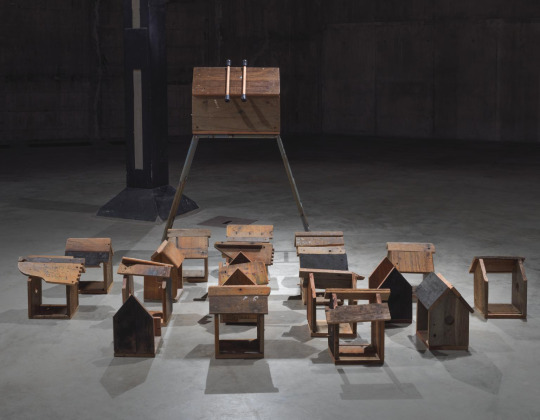

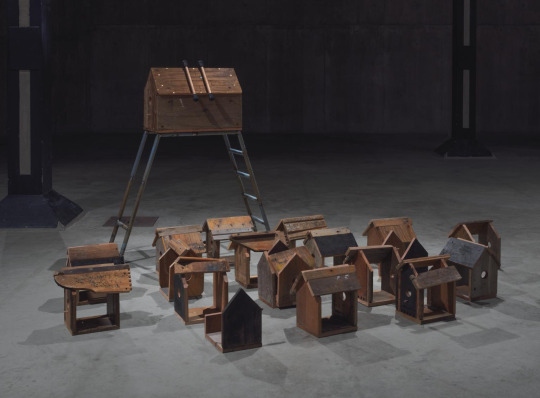
I cut my skin to liberate the splinter: Act 3 2017 includes a birdhouse fabricated from salvaged school desks on top of a metal structure. Two wooden drumsticks balance on the side of the roof, while a further four drumsticks are neatly arranged on the floor below the structure. Twenty smaller birdhouses, also constructed out of old school furniture, are stacked around the main element. In Wa Lehulere’s work, bird houses are a recurrent theme and symbolise entrapment, forced removal, homelessness and migration. Wa Lehulere was raised in Gugulethu, a residential area created in the 1960s for black people who were not permitted to live in Cape Town and were forcibly removed to the township. During the performance, the larger birdhouse is played like a drum while the smaller birdhouses are rearranged, increasingly frenetically, by a single performer who proceeds to lie down and thread the structures onto her limbs, transforming the performer’s body into a hulking, immobile form.
[Source ‘I cut my skin to liberate the splinter: Act 1‘, Kemang Wa Lehulere, 2017 | Tate]
0 notes
Text
I cut my skin to liberate the splinter: Act 2
Medium: 3 rubber tyres, 4 wooden crutches, reconfigured metal school desks, 3 porcelain dogs, torch and cloth
[Source ‘I cut my skin to liberate the splinter: Act 1‘, Kemang Wa Lehulere, 2017 | Tate]

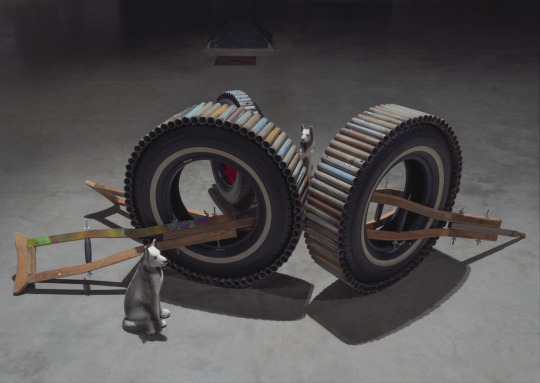
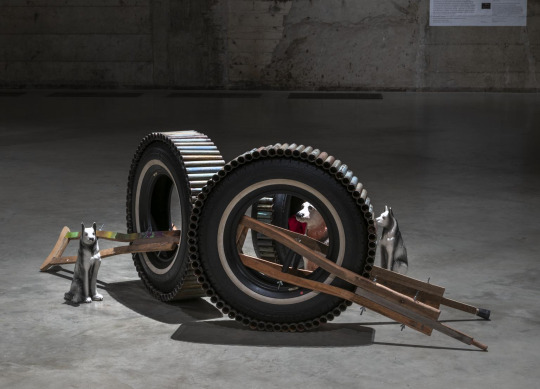
I cut my skin to liberate the splinter: Act 2 2017 is made up of three rubber tyres and four wooden crutches. Attached to the tyre treads are short lengths of metal tubing, salvaged from the legs of old school desks and welded together. As with the school desks, the rubber tyres are a childhood motif for Wa Lehulere. In impoverished areas of South Africa, children frequently play with abandoned car tyres. In wealthier communities, tyres are often repurposed into children’s swings. While this material is associated with the innocence of childhood, in the South African context it also recalls burning tyre blockades and the practice of necklacing, a particularly gruesome form of mob justice (a car tyre would be forced over the head and around the arms of the suspect before it was drenched in petrol and set alight) reserved for those thought to be government collaborators or informers during the apartheid era. The modified tyres and crutches symbolise injury and injustice, but also hold the promise of mobility and play. When activated, two performers use the crutches to wheel around the tyres, while at other moments a single performer stands on top of one tyre and uses the crutches to move around. Meanwhile three porcelain dogs stand by.
[Source ‘I cut my skin to liberate the splinter: Act 1‘, Kemang Wa Lehulere, 2017 | Tate]
0 notes
Text
I cut my skin to liberate the splinter: Act 1
This is one element of a large-scale multi-part work that comprises six sculptural installations – I cut my skin to liberate the splinter Act 1–5 and I cut my skin to liberate the splinter: Please remember on my behalf, all2017 (Tate T15274–T15279). They can be shown individually or together as a single work, as they were on their initial presentation during Performa 17 Biennial in New York in November 2017, which earned the artist the fourth Malcolm McLaren Award.
Medium: Reconfigured wooden school desks, 96 glass bottles with cork tops, steel bath, acrylic tank, acrylic pipe, water, moulded plastic valves, metal flutes, sand, paper and ribbon
[Source ‘I cut my skin to liberate the splinter: Act 1‘, Kemang Wa Lehulere, 2017 | Tate]


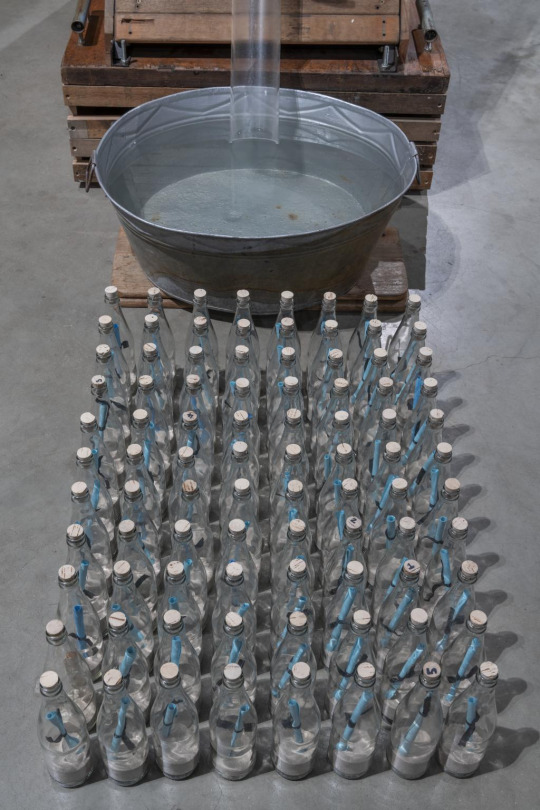
I cut my skin to liberate the splinter: Act 1 2017 comprises a right-angled triangular form, over three metres high, constructed out of salvaged school desks. Wa Lehulere frequently utilises school furniture in his work to address questions around how knowledge is imparted, and to refer to student activism during apartheid and contemporary struggles for access to, and transformation in, education. Wa Lehulere has said: ‘I believe the education system is the most important aspect to begin with because it is where people are shaped. At the moment and for a long time the education system [in South Africa] has not produced people that think critically, but rather people who fit in the system.’ (Quoted in Aïcha Diallo, ‘The Desire to no Longer Be Silent’, Contemporary And, 31 March 2017, https://www.contemporaryand.com/magazines/the-desire-to-no-longer-be-silent/, accessed 9 May 2018).
Completing this sculpture is a clear acrylic tube fixed to the diagonal side of the triangle, connecting a transparent rectangular tank at the apex with a round steel bath filled with water at the base. Ninety-six glass bottles sealed with cork stoppers and containing sand and blue paper scrolls tied with ribbon are arranged in a grid in front of the bath. When activated during a performance, the bottles are slowly fed into the acrylic pipe and – by way of pressure controlled by three gates – travel up the pipe to the tank where they are fished out of the water by a performer atop the structure who reads out the messages in the bottles. At other moments bubbles are blown into the water pail with one of five metal ‘flutes’. The flotation and chamber system Wa Lehulere has created in this work is based on the water shaft theory, which postulates that the Ancient Egyptians used pressurised water to move the massive limestone blocks used in constructing the Giza Pyramids.
[Source ‘I cut my skin to liberate the splinter: Act 1‘, Kemang Wa Lehulere, 2017 | Tate
0 notes
Text
I cut my skin to liberate the splinter (2017)
Kemang Wa Lehulere's significant work, "I cut my skin to liberate the splinter," stands as a culmination of his artistic exploration over the past decade. It mirrors his consistent themes and incorporates found materials reflecting his upbringing in apartheid South Africa. Addressing issues of history, memory, home, exile, longing, and displacement, the piece delves into various aspects of South African history, including the forced removal of black South Africans, exile during apartheid, student uprisings in the 1970s, and the lead-up to the 1994 democratic elections.
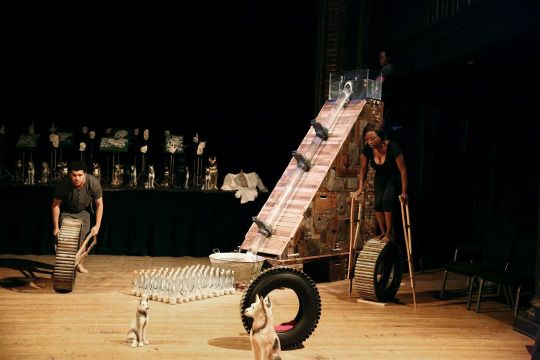
The title's explanation by Wa Lehulere emphasizes the poetic act of self-liberation from pain as a gesture of generosity and a longing for freedom. The artwork draws inspiration from the documentary "Cosmic Africa" (2003), which explores African astrophysicist Thebe Medupe's quest for cosmic understanding through ancestral knowledge. Wa Lehulere's work aligns with the historical role of African artworks in preserving and communicating knowledge, as highlighted in the documentary.
I cut my skin to liberate the splinter: Please remember on my behalf 2017 comprises twenty-six porcelain dogs, twenty-four music stands, twenty-four resin-cast hands and six chalkboards, carefully configured in an orchestral-type arrangement.The porcelain dogs, which appear elsewhere in this piece and across Wa Lehulere’s work, are mass-produced souvenirs that, according to the artist, adorn many South African homes (correspondence with Tate curator Kerryn Greenberg, 9 May 2018).
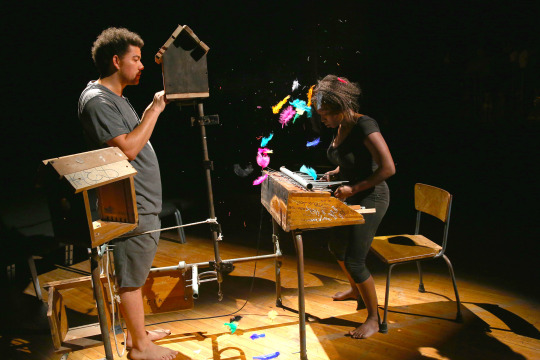
Like many of Wa Lehulere’s chosen materials, the porcelain dogs stand in for a range of experiences, histories and meanings. During apartheid, German Shepherds were the breed of choice for the police; these dogs were trained to be aggressive by their white handlers and were feared and hated by black South Africans. Interspersed between the dogs and music stands are enlarged white resin casts of hands signing the words ‘please remember on my behalf’, alluding to issues around accessibility, but also to empowerment and memory.
Wa Lehulere cast these pieces from the hands of his Aunt Sophia Lehulere, who had been involved in the student uprising of 1976. Wa Lehulere has explained that he intended these hands to be an ‘homage to a larger cohort of students, both those who survived and especially those who didn’t survive the violence’ (correspondence with Tate curator Kerryn Greenberg, 9 May 2018). The chalk drawings on green boards meanwhile represent pedagogy but, with the marks obscured and rubbed out in places, also speak to the fallibility and transience of memory.

[Source: ‘I cut my skin to liberate the splinter: Act 1‘, Kemang Wa Lehulere, 2017 | Tate]
[Picture Source: Robert Wuss - Kemang Wa Lehulere (myportfolio.com)]
0 notes
Text
Kemang Wa Lehulere - The Chosen One
I've zeroed in on Kemang Wa Lehulere from the Tate website for my project. What caught my eye were his installations and diverse exhibitions, characterized by a captivating abstract nature.
This seems like a perfect fit for the brief's aim to transform abstract concepts into a game level. Kemang's installations hold profound meaning, and I'm eager to unravel the depths of significance behind some of his works in the upcoming blog posts.
Kemang Wa Lehulere was born in 1984 in Gugulethu, Cape Town, and lives and works in Johannesburg. Engaging with a range of media, including sculpture, installation, drawing, and performance, Kemang Wa Lehulere crafts environments using found objects and salvaged materials. His work intertwines personal memories with collective narratives, using items like school desks, tires, chalkboards, and ceramic dogs to explore the nuanced and potentially subversive meanings of objects. By reconfiguring and assembling these materials, he poetically highlights their 'double lives' and multiple interpretations.
Wa Lehulere addresses the trauma of South Africa's contemporary history by employing physical acts of excavation and deconstruction. Collaborating across time, he references, re-frames, and engages in 'call-and-response' with artists, writers, and family members significant to him. Through his exhibitions, he not only showcases his own work but also highlights other practitioners, emphasizing the politics of cultural erasure and prompting reflection on the gap between individual experiences and official historical accounts.
Wa Lehulere's visual language, influenced by institutions, contributes to the discourse on structural violence, emphasizing the importance of decolonized education and theoretical research. His work urges us to consider the urgency of reevaluating historical narratives and acknowledges the complexity of lived experiences often overlooked in sanctioned accounts.
Sources:
Kemang wa Lehulere (2020) YBCA. Available at: https://ybca.org/artist/kemang-wa-lehulere/
Kemang wa Lehulere Bio (no date) blank projects. Available at: https://blankprojects.com/Kemang-Wa-Lehulere-Bio
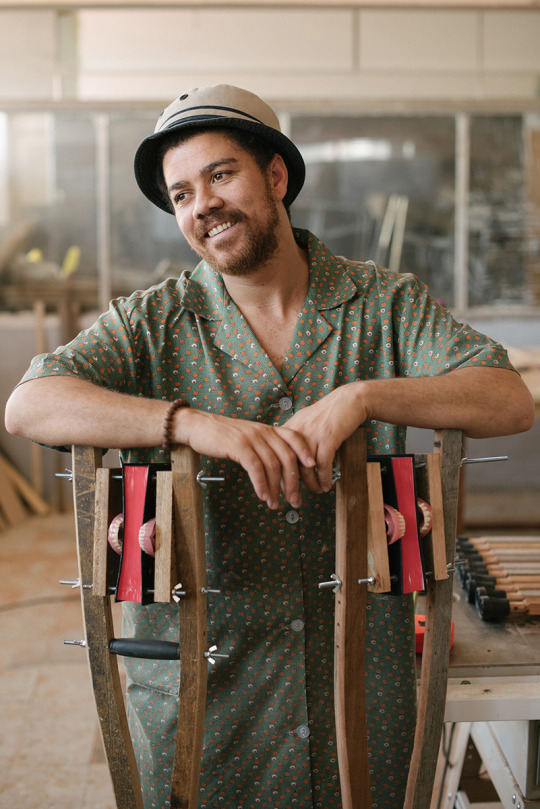
0 notes

